After an exciting couple of days in and around Machu Picchu,
we took the train back to Ollantaytambo, the town where we'd previously spent a few days, close to 9. Because of the mountains
and the curves, the speed was limited to between 35-40 kph. Included in the
price of the train ticket was free mango juice and Inka corn chips – whoopie
after $70 pp for the 90-minute trip!
We saw people starting the four-day trek to Machu Picchu, something we'd never considered doing!
Months ago, we’d made arrangements for a driver to pick us up from the train station and drive us to the town of Cusco, located about 60
miles away. Since there were several interesting towns we wanted to see between
Ollantaytambo and Cusco, it made more sense to stop en route rather than
backtracking and making a separate day trip in a few days, we had figured.
After picking up our suitcases we had left at our hotel in
Ollantaytambo while we’d been in Machu Picchu Pueblo, we were on our way to Salineras, the first town in the Sacred
Valley and located an hour away. The driver made a quick stop first to show us
the Inca Bridge in Ollantaytambo.
The bridge was made of stone and mortar, which was one of the many techniques used by Peru's ancestors. The pillar and ancient Inca bridge still remained standing and supported the modern bridge. Our first stop would be an hour away in the white city of Salineras, a town unique in the Sacred Valley, where the Incas transformed nature by digging shallow, terraced salt pans or pools into a sloped hillside.
Photos en route:
The photo was of overlooking Salineras:
Neither Steven nor I can remember the significance of the numbers on the hillside as we drew near to the large town of Urabamba. I think they had to do with the local school but don't hold me to it!
This was all part of the magnificent Andes we’d seen a few days ago. The driver said there was never snow at the lower
elevations.
Our driver said the houses were built here to indicate the land was owned by
individuals but the homes were always left vacant. The inference was the land couldn't therefore be developed by the government or others.
Corn, fava beans and wheat were grown in the fields.
I got excited as we approached Salineras and able to see exactly what the salt pools looked like.
The road down to Salineras was so narrow that cutouts were
needed to allow buses and cars to pass.
The driver said nobody lived in the town of Salineras as
it was only a working town; instead, they lived in the nearby town of Maras.
It was an amazing sight viewing
the huge number of salt pools that seemed to go on forever.
Irrigation to the salt pools was provided by rainwater and the channels in the river from the town of Chinchero that we’d also be stopping at that afternoon. A spring of warm, salty water was diverted into thousands of pools where sunlight evaporates the water and leaves a thin crust of salt.
Being able to walk along the
narrow, crunchy path rather than just viewing the salt pools from a platform at a
distance made the experience pretty remarkable.
It was amazing to think that the Incas harvested salt in the same way.
We watched as one of the workers was redirecting the flow of
water to specific pans.
There were 5,740 salt pools, each of which yielded 150 kilos of unrefined salt per month. The pools have been passed down through the generations among 400 families. The water flowing through these mines was sixty percent salt, twice the salinity of the ocean.
We wondered at the weight of
the enormous bags of salt the men were carrying on their backs. When we got
back to the car, Richard, the driver, told us that 150 kgs of salt were collected each month from each pan. The men
were carrying a staggering 50kgs of salt each on their backs – well more than
100 pounds!
The men could only work until they were about 50 because of the damage to their bodies. Richard pointed out that entire families worked in the salt fields and that children started as young as 10, carrying from 10-20 kgs of salt when not in school. The families walk back and forth daily from their homes in Maras to work in Salineras, a distance of five miles.
We were curious as to why there were so few workers in the pans when we were there. Richard informed us that from October to March there was no good salt harvest because that was the rainy season. During that time, the workers toil in the fields instead. Since there are often landslides and rain that destroy the pools, they have to be rebuilt year after year.Sadly, a sign of the times:
It was more than a tad strange that a distinctive Peruvian
take of Paul McCartney’s song ‘Let It Be’ was being played over loudspeakers
while we were walking around! We’d never heard the song with pan pipes and a
flute before!
Souvenirs included bags of every variety of salt and in a variety of sizes.
The town square in Maras included a monument depicting Salineras' salt
pans, the agricultural terraces of Moray and other Sacred Valley communities of Chequl and Tiobamba.
Richard stressed that only
locals live in Maras and that there were no facilities for tourists.
The sign said, "Christ is coming soon. Let us prepare."
Driving through Maras was the first time we’d seen a sign complaining about the presence of cars. Effectively it translated as cars contaminate our area.
As we drove on to the town of Moray next, Richard said children in Peru were
expected to go to school from 6-16 but the parents were allowed latitude if the
children were needed elsewhere.
It was impossible not to be awed with almost every view of the Andes.
About 50 km from Cusco, a little off the beaten track, were the visually stunning Inca ruins of Moray, located in a remote area of the Sacred Valley. Because the Moray ruins aren’t mentioned in many guide books, they are not inundated with visitors.
While Richard stayed in the car, we had a long hike down to marvel up close at the agricultural technology used by the Incas at Moray. Taking advantage of four natural depressions in the ground and angles of sunlight, indigenous engineers fashioned concentric circular irrigation terraces. The full purpose behind these concentric terraces isn’t fully known. However, it is widely believed that the ruins were once an agricultural laboratory used by the Incas. The circular terraces are thought to have been used as an agricultural research station.
The deep bowl-shaped hollows of Moray looked like a Roman amphitheater. They were circular in shape and had stair-like terraces climbing up to the valley floor above.
It was remarkable that we had
the entire area to ourselves. As Steven said, no one else was as foolish as we
were to go down there in that heat! The only sounds we heard were of sheep
bleating and the wind blowing.
We enjoyed the experience of navigating the stone
steps going from one level down to the next terrace.
But, I was just as glad we only chose to go down one set of these ancient Inca steps!
I read that it was no coincidence that the temperature differences at Moray represented the temperature at sea level farmland and the temperature in Andean farming terraces. The Incas were beyond their time in scientific thinking. Studies done on the soil have shown that the soil came from different regions and must have been brought to the Sacred Valley.
This again showed that the Incas were using this area as an experimental zone. Another fascinating point to note about the Moray ruins is that they never flood, even in Peru’s unremitting rainy season. It is thought that there must be underground channels built to allow the water to drain.
There wasn't simply one set of concentric terraces at Moray even though that alone would have been fantastic. There were several other sets of terraces throughout the massive complex.
We wondered why there were piles of
rocks in this area. Possibly for ceremonial purposes?
There were no steps from level
to level so we just walked down.
We noticed another depression
beyond the rocks and a sign that said we were at an elevation of 3,510 meters or more than 11,000 feet above sea level. This spot was called Intiwatanamuyu. There were more piles of rocks and we figured,
finally (!), that they were used to reconstruct the broken walls.
Richard later told us that it would take a further two years to rebuild the walls. The university had grown crops here to recreate life of a bygone age but the government took the site over and made Maras an architectural site.We were both awed by Moray's expanse and marveled at the forward thinking and intelligence of the Incas.
Much to Steven's dismay because we still had more places to visit that afternoon, I spent a few minutes looking at, and buying, a few of the lovely handcrafted items!
I felt sorry for the woman who
was nursing her child and had to run over and shoo her flock away so we could
pass by.
As we drove back through Maras, it was impossible to miss all
the exclusively blue painted doors. Richard said that the Spanish colonial authorities had
ordered them to be painted blue centuries ago and the tradition had been maintained.
We happened to drive by the
Maras cemetery en route to the town of Chinchero, located a further 40 minutes
away.
It was shocking to see a pig
being slaughtered with a hatchet on the side of the road. Now, with 20/20 hindsight, it shouldn't have been as that was customary for that culture.
The beautiful Chinchero Lake:
This was the first time since arriving in the Sacred Valley we had seen mud-brick homes. They were also far larger than those we'd seen earlier.
It was also new seeing so many homes
and walls painted with elections signs; they seemed never ending!
The highlight of our drive was
supposed to have been the stops in Chinchero,
the largest town in the Sacred Valley and one of the valley’s major Inca
cities. According to indigenous lore, it was also the birthplace of the
rainbow. Apparently, if we’d been there during the rainy season, frequent
sightings of rainbows might have convinced us of the legend’s truth!
Richard dropped us off at a
bottom of a hill and pointed, very vaguely we later realized, toward where the
town’s church should be. Only after asking in pidgin Spanish were we able to discover
the colonial church located in the central plaza above the market.
Because the elevation was so much higher in Chinchero and as we were nearing Cusco, we had to stop and catch our breath a couple of times walking up to the church.The weather had just started to get pretty nasty so the women hoping to sell their crafts in the church courtyard had to cover them up unfortunately.
How adorable was this babe!
Built in 1607, the church was built on top of the limestone remains of an Inca palace thought to have been the country estate of the son of the first Inca ruler.
The church reminded us both immediately of one we had seen in Ethiopia last year that also had gorgeous angels painted on the ceiling and walls.
The entrance way also had superlative paintings which we hadn't noticed when we had made our mad dash into the church a little earlier.
The hike back to the car!
We had made plans months ago to
stop at a specific weaving center in Chinchero as it was regarded as being one
of the best weaving centers in Peru. However, Richard for some reason took us
to another one called Centro Textil.
It was hard to focus on what Luz Marina was saying as her children provided far more interesting entertainment, especially since we'd already seen another weaving demonstration and wool being dyed!
The green color came from using
herbs and blue from two plants mixed together.
The purple was achieved by
using chicha morada, the potent
beverage.
The lovely blue shades came from two plants: tara and esquinas.
The brown came from lichen moss and the yellow from seeds.
Luz Marina showed us a table runner
she had made and the significance of each of the designs in the pattern: the eyes
of the puma; the Andes mountains; the Inca calendar, the two lakes in Chinchero
representing a man and a woman and the claws of the condor. On the border were
the Inca princesses’ eyes.
Even though the 'weaving demonstration' was ostensibly free like any 'free walking tour', I felt I had to buy something after the time that had been spent on us. I chose an alpaca scarf for Cory, our soon to be daughter-in-law that Luz Marina had created. I gave it to her when she, Alexander and her family were with us for Christmas - luckily she liked it!
Alpacas kept on site meant there was a steady supply of wool!
I don't know who laughed harder as I also tried my long dormant hoola hoop skills!
We only had time to see the town square in Chinchero because it was getting so late. We were disappointed that we
saw so little in Chinchero as that was supposed to have been the highlight of our day touring the Sacred Valley. But it was hard to mope too much as our visits to both Salineras and Moray had been far better than either of us expected.
As we left Chinchero, we saw
countless signs painted with a rainbow and the letters ‘MT’ on it. They were
signs belonging to a specific political party, according to Richard. All the
rainbow flags we saw on the road and later in Cusco itself made the city seem
very gay-friendly. Those flags, though, were actually the flag of Cusco and
based on the banner of the Inca Empire!
What a beautiful approach to Cusco, the most important city in Peru's Sacred Valley, and our 'home' for the next four nights!
We soon discovered that the charming city of Cusco should be called 'The City of Hills'!
Next post: Discovering Charming Cusco.
Posted on January 8th, 2018, from Littleton, Colorado.








































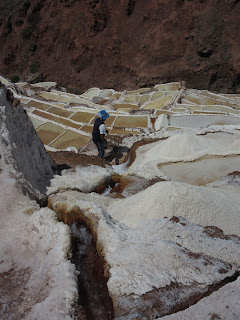



















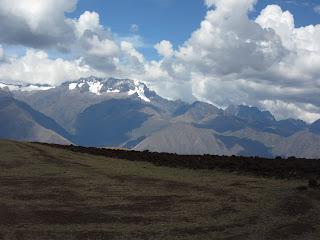
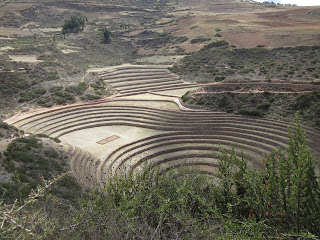

























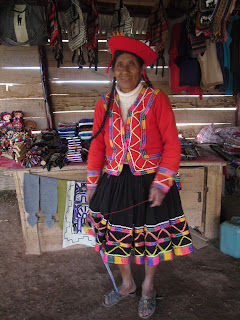



































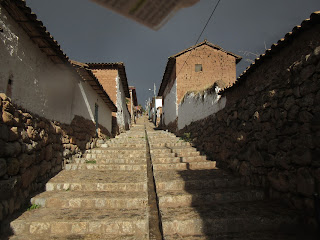





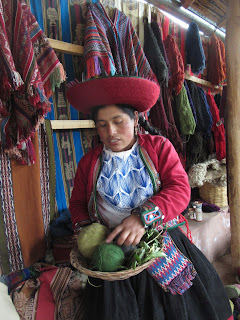















The Moray area and salt ponds, Salineras, is so fascinating! So that's how inland people got salt. There must have been traders who carried it near and far. Everything looked very dry, so I was glad when there were little rain spats in the air (and on your camera lens). The lovely visit to Luz Marina (?) was special. Steven was his fascinated, charming self, respecting the artist who was sharing her craft info with him. Alpaca is the softest, least itchy wool, and the animals are much nicer than llamas (a Littleton foothills alpaca farmer told me). Smarter than sheep, as well---companionable animals . Thanx!!
ReplyDeleteMarti,
ReplyDeleteHappy to know you enjoyed reading about our long but very enjoyable day trip from Machu Picchu to Cusco by way of Maras, Salineras and Chinchero, three communities in Peru's Sacred Valley.